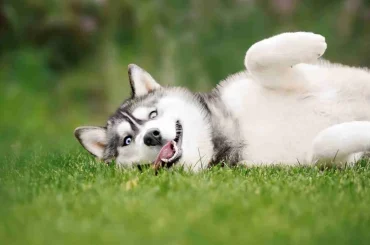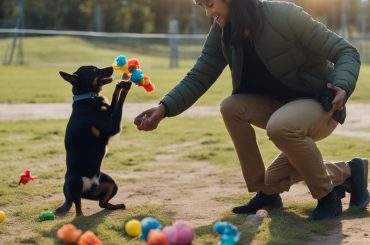Teaching your dog to put away his or her toys can be both practical and fun. It not only helps keep your home tidy but also strengthens the bond between you and your furry friend. According to the CDC, nearly 10% of pet-related fall injuries are caused by tripping over dog toys. By teaching your dog to put toys in a basket, you can avoid accidents and make toy clean-up easier.
Key Takeaways:
- Teaching your dog to put toys in a basket promotes organization and reduces the risk of accidents.
- Positive reinforcement is essential for teaching your dog this new skill.
- Breaking down the sequence of behaviors and using treats can help your dog learn to retrieve and drop toys in the basket.
- Consistency and patience are key when training your dog to put toys away.
- Maintaining the behavior by incorporating toy clean-up into your daily routine will ensure long-term success.
Why Teach Your Dog To Put Toys In Basket?
Teaching your dog to put toys in a basket has several benefits. Firstly, it helps with toy organization, keeping your home tidier and reducing the risk of tripping over toys. By training your dog to put away their toys, you create a designated space for them, making it easier for you to find and access toys when needed.
Furthermore, teaching your dog to put toys in a basket is an excellent way to address certain dog behaviors. It engages their natural instincts and provides mental stimulation, which can prevent boredom and destructive behavior. By teaching your dog this skill, you are giving them a productive task to focus on, keeping their minds active and engaged.
Lastly, teaching your dog to put toys in a basket strengthens the bond between you and your four-legged friend. The training process allows you to spend quality time together, building trust and reinforcing positive communication. It is a collaborative activity that deepens your connection and enhances your overall relationship.
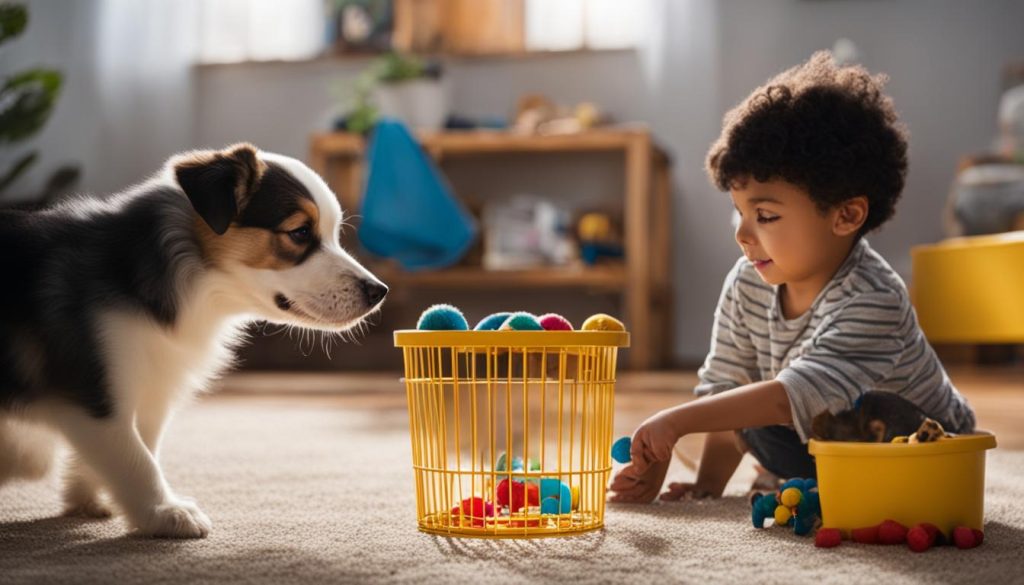
Table: Benefits of Teaching Your Dog to Put Toys in a Basket
| Benefit | Description |
|---|---|
| Toy Organization | Keeps your home tidier and reduces the risk of accidents |
| Mental Stimulation | Engages your dog’s instincts and prevents boredom |
| Bonding | Strengthens the bond between you and your dog |
Gathering the Necessary Supplies
Before you begin teaching your dog to put toys in a basket, I would advise that you gather the necessary supplies. Here’s what you’ll need:
- Dog toys: Choose a variety of toys that your dog enjoys playing with. These toys will be used during the training sessions.
- Tasty treats: Use small, bite-sized treats that your dog finds irresistible. These treats will serve as rewards for your dog’s successful toy retrieval and placement in the basket.
- Clicker: If you use a clicker for training, have it ready during the sessions. The clicker will help mark and reinforce your dog’s desired behavior.
- Toy box: Set up a designated toy box or basket where your dog will place the toys. Make sure it’s easily accessible for your dog and large enough to hold all the toys.
- Dog training supplies: Have any additional training supplies handy, such as a leash, if necessary.
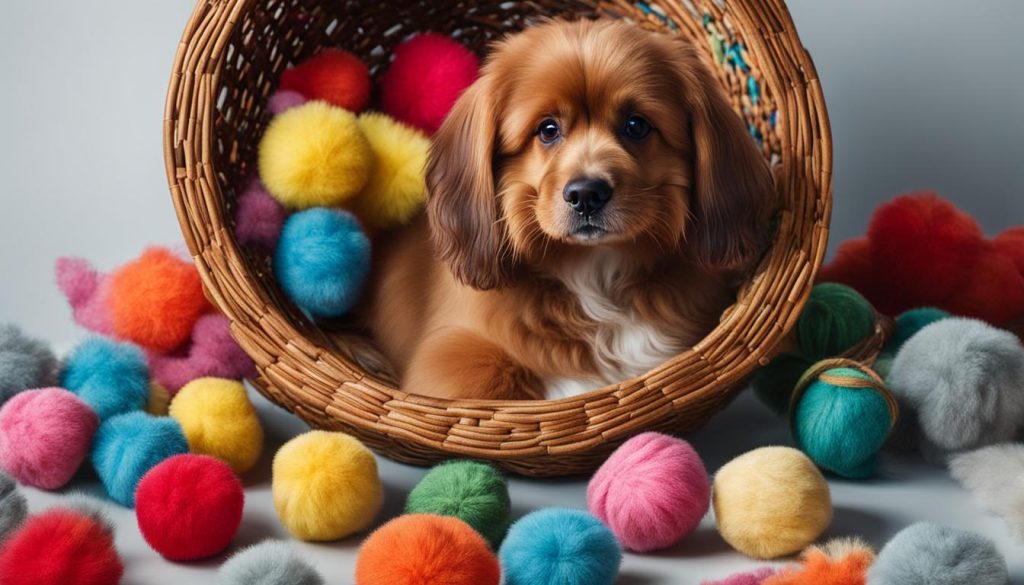
By having these supplies ready, you’ll create a conducive environment for teaching your dog to put toys in a basket. To put it simply, positive reinforcement and consistency are key to success in dog training.
Breaking Down the Sequence
To effectively teach your dog to put toys in a basket, break down the sequence into manageable steps. This approach ensures that your dog understands each behavior individually before moving on to the next. The following steps outline the teaching sequence:
- 1. Teach the “take it” command: Start by teaching your dog to pick up a toy on cue. Use a favorite toy and reward your dog with a treat when they successfully take the toy in their mouth. Repeat this step until your dog consistently responds to the “take it” command.
- 2. Encourage the “bring it” behavior: Once your dog is comfortable picking up toys, work on getting them to bring the toy to you. Use the “bring it” command and encourage your dog to come towards you with the toy in their mouth. Reward and praise them when they bring the toy to you.
- 3. Teach the “drop it” command: The next step is to teach your dog to drop the toy on cue. Use the “drop it” command and encourage your dog to release the toy from their mouth. Reward and praise them when they drop the toy. Practice this step until your dog consistently responds to the “drop it” command.
- 4. Introduce the “put your toys away” command: Once your dog is proficient at bringing and dropping toys, introduce the command to put the toy in the basket. Point to the basket and use the command “put your toys away.” Encourage your dog to place the toy in the basket and reward them when they do so. Gradually increase the distance between your dog and the basket as they become more confident.
Try to use positive reinforcement, treats, and praise throughout the training process to motivate and reward your dog for their progress.
Breaking Down the Sequence
Teaching your dog to put toys in a basket involves a sequence of behaviors that need to be broken down and taught individually. By following these steps, you can help your dog understand and perform each behavior with ease.
“Take it” command: Teach your dog to pick up the toy on cue.
“Bring it” behavior: Encourage your dog to bring the toy to you.
“Drop it” command: Teach your dog to release the toy on cue.
“Put your toys away” command: Introduce the command to put the toy in the basket.
By gradually introducing and reinforcing each step, your dog will learn the sequence and be able to put their toys away in the basket with confidence. This training not only provides mental stimulation but also strengthens the bond between you and your dog.
Getting Started
When it comes to teaching your dog to put toys in a basket, getting started is an exciting part of the process. Try to approach the training sessions with patience and a positive attitude. Here are some helpful dog training tips to help you get started:
- Choose a designated basket or toy box for your dog’s toys. Make sure it is easily accessible for your dog and large enough to hold all the toys.
- Start by tossing your dog’s favorite toy a short distance away from the basket. Encourage your dog to pick up the toy and bring it back to you using the command “bring it”. Reward your dog with praise and treats for successfully retrieving the toy.
- Once your dog is consistently bringing the toy back to you, gradually move closer to the basket. Encourage your dog to drop the toy near the basket using the command “drop it”. Reward your dog for dropping the toy in the general vicinity of the basket.
- Continue shaping the behavior by rewarding your dog for dropping the toy closer and closer to the basket. Eventually, your dog will understand that the goal is to drop the toy inside the basket.
Try to use positive reinforcement, such as treats and praise, to motivate your dog and make the training process enjoyable. Keep training sessions short and frequent to maintain your dog’s interest and progress steadily towards the desired behavior.
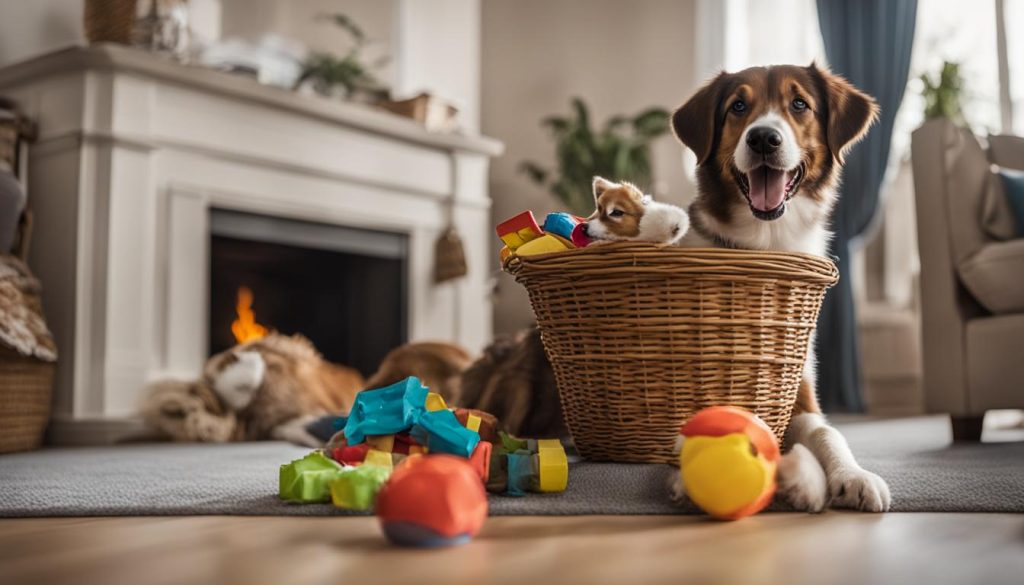
Common Challenges
During the training process, you may encounter some challenges. Here are a few common ones and how to address them:
“My dog doesn’t want to drop the toy.”
If your dog is reluctant to drop the toy, try using higher-value treats as a reward. You can also use a “trade” technique, offering another toy or treat in exchange for the one in their mouth.
“My dog is easily distracted.”
If your dog gets easily distracted during training, choose a quiet and calm area to minimize distractions. Gradually increase the level of distractions as your dog becomes more proficient in the behavior.
“My dog loses interest in the training.”
If your dog loses interest, make sure the training sessions are short and fun. Incorporate playtime and other activities that your dog enjoys to keep them engaged and motivated.
By addressing these challenges and being patient with your dog, you can overcome obstacles and continue making progress in teaching your dog to put toys in a basket. To put it simply, consistency and positive reinforcement are key to successful obedience training.
Reinforcing the Behavior
Once your dog has become proficient at retrieving and dropping toys in the basket, you should reinforce the behavior to ensure long-term success. Consistency is key in dog training, so continue using the command to put the toys away and reward your dog for each successful deposit. This positive reinforcement will help your dog understand that putting toys in the basket is the desired behavior.
To further reinforce the behavior, gradually add more toys to the training sessions. Start with one toy, then gradually increase the number as your dog becomes more comfortable and skilled. This will help your dog generalize the behavior to different toys and reinforce the idea that all toys should be put away in the basket.
Practice the behavior in different locations and gradually increase the distance between the toys and the basket. This will help your dog transfer the skill across different environments and reinforce their understanding of the command in various contexts. You should challenge your dog and expose them to different scenarios to solidify their understanding of the behavior.

Incorporating regular training sessions into your daily routine will help maintain the behavior. Set aside dedicated time each day to practice putting toys in the basket with your dog. This will reinforce the habit and ensure that your dog continues to put their toys away consistently. Try to use positive reinforcement, such as treats and praise, as rewards to motivate and encourage your dog throughout the training process.
By reinforcing the behavior and maintaining consistent training, your dog will learn to put toys in the basket reliably. This skill will not only make toy clean-up easier but also demonstrate your dog’s obedience and ability to follow commands. Enjoy the process of training and playing with your furry friend as you work together to achieve this useful behavior.
Troubleshooting Challenges
Training your dog to put toys in a basket can come with its fair share of challenges. Each dog is unique and may require different approaches to overcome these obstacles. Here are some common challenges you may encounter and tips on how to troubleshoot them:
1. Difficulty with the “Drop It” Command
Sometimes, dogs may struggle with letting go of the toy when prompted to “drop it.” This can be due to possessiveness or a lack of understanding the command. To address this challenge, start by teaching a solid “drop it” command separately from the toy retrieval sequence. Use high-value treats to encourage your dog to release the toy willingly. Once they are consistently responding to the command, reintroduce it during the toy clean-up training sessions.
2. Loss of Interest or Distractions
Some dogs may lose interest in the training or become easily distracted by their surroundings. To keep your dog engaged, vary the training sessions by using different toys and incorporating play breaks. Keep the training sessions short and frequent, focusing on quality rather than quantity. Minimize distractions in the environment and gradually increase the level of difficulty as your dog progresses.
3. Seeking Professional Assistance
If you are facing significant challenges or struggling to modify your dog’s behavior, it may be beneficial to seek help from a professional dog trainer or behaviorist. They can provide personalized guidance, identify underlying issues, and create a customized training plan to address your dog’s specific needs.
To put it simply, consistency, patience, and positive reinforcement are key when troubleshooting challenges during the toy clean-up training. Each dog learns at their own pace, so you should adapt your training methods to suit their individual needs. With time and dedication, you can overcome any obstacles and successfully teach your dog to put toys in the basket.

Building on the Skill
Once your dog has mastered the skill of putting toys in a basket, you can take their training to the next level by teaching them advanced tricks and commands. Canine training is a continuous process that allows you to build upon the foundation you have already established. By introducing new challenges and commands, you can further enhance your dog’s obedience and mental stimulation.
Teaching advanced tricks to dogs requires patience, consistency, and positive reinforcement. Start by selecting a new command or trick that you would like your dog to learn, such as “roll over” or “play dead.” Break down the trick into smaller steps and use the same training techniques you used for teaching them to put toys in a basket.
“Training a dog is not just about teaching them new tricks but also about deepening the bond between the two of you. The process of learning together strengthens your connection and builds trust.”
As you introduce new commands, remember to keep training sessions short and fun. Use rewards, such as treats or praise, to motivate your dog and reinforce desired behaviors. Consistency is key in training, so practice the new trick regularly until your dog is comfortable and confident in performing it.
Example: Advanced Trick Training
| Trick | Step 1 | Step 2 | Step 3 |
|---|---|---|---|
| Roll Over | Lie down | Guide them to roll onto their back | Reward and praise when they complete the roll |
| Play Dead | Lie down | Guide them to roll onto their side | Pretend to shoot them with your finger and say “bang” |
| Shake Hands | Offer your hand | Guide their paw to touch your hand | Reward and praise when they make contact |
Try to always use positive reinforcement and never force your dog to perform a trick. If your dog is struggling with a particular trick, go back to the basics and reinforce their understanding of commands they have already learned. With patience and practice, your dog will continue to impress you with their ability to learn and perform advanced tricks.
Maintaining the Behavior
After successfully training your dog to put toys in a basket, you should maintain the behavior. Make it a part of your daily routine and reinforce the behavior regularly with praise and rewards. Keep the toy box easily accessible and encourage your dog to use it consistently. This will help ensure that your dog continues to put their toys away and keeps your home organized.
| Key Points to Don’t forget for Maintaining the Behavior |
|---|
| 1. Consistency is key: Make putting toys in the basket a regular part of your dog’s daily routine. Set specific times for toy clean-up and encourage your dog to participate. |
| 2. Positive reinforcement: Continue to reward your dog with praise and treats for successfully putting toys in the basket. This will reinforce the behavior and motivate your dog to continue doing it. |
| 3. Accessible toy box: Ensure that the toy box or basket is easily accessible for your dog. Keep it in a designated area where your dog can easily reach it. This will make it more convenient for your dog to put away toys. |
| 4. Regular practice: Even after your dog has mastered the skill, continue to practice putting toys in the basket. This will help maintain the behavior and keep it fresh in your dog’s mind. |
By following these tips, you can ensure that your dog continues to put toys in the basket and keeps your home organized. To put it simply, maintaining the behavior is just as important as teaching it in the first place. With consistency and positive reinforcement, your dog will continue to excel at toy clean-up and obedience training.
Final Thoughts
Teaching your dog to put toys in a basket is a valuable skill that benefits both you and your pet. Not only does it promote a clean and organized home by minimizing toy clutter and reducing the risk of tripping, but it also provides mental stimulation for your dog. Additionally, this training activity strengthens the bond between you and your furry friend, fostering a deeper connection.
When embarking on this training journey, remember to be patient and use positive reinforcement techniques. Encourage your dog with treats and praise for each successful attempt, and make the training sessions enjoyable for both of you. Consistency is key, so practice regularly and integrate the behavior into your daily routine. By doing so, you can ensure that your dog continues to put their toys away and maintain an organized living space.
As you witness the success of teaching your dog to put toys in a basket, you can also use this foundation to teach them more advanced tricks and commands. This opens up a world of possibilities for you to explore and expand your dog’s repertoire of behaviors. Try to always maintain the behavior through regular reinforcement and encourage your dog to use the toy basket consistently. Enjoy the training process and have fun playing and bonding with your furry friend!
FAQ
Why is teaching my dog to put toys in a basket beneficial?
Teaching your dog to put toys in a basket has several benefits. It helps with toy organization, reduces the risk of tripping over toys, engages your dog’s natural instincts, provides mental stimulation, and strengthens the bond between you and your dog.
What supplies do I need to teach my dog to put toys in a basket?
You will need your dog’s favorite toys, tasty treats for rewards, a clicker (if you use one for training), and a designated toy box or basket where your dog will put the toys.
How do I break down the sequence of teaching my dog to put toys in a basket?
Start by teaching your dog to pick up the toy on cue (“take it”). Then, work on getting them to bring the toy to you (“bring it”) and drop it on cue (“drop it”). Once they are consistently bringing and dropping the toy, introduce the command to put the toy in the basket (“put your toys away”).
How do I get started with teaching my dog to put toys in a basket?
Begin by tossing their favorite toy and encouraging them to pick it up and bring it to you. Then, encourage them to drop the toy near the basket. Gradually shape the behavior by rewarding them for dropping the toy closer to the basket, and eventually for dropping it in the basket itself.
How do I reinforce the behavior of putting toys in a basket?
Continue using the command to put the toys away and reward your dog for each successful deposit. Add more toys to the training sessions and practice in different locations. Gradually increase the distance between the toys and the basket.
What should I do if I encounter challenges while training my dog to put toys in a basket?
If you face difficulties, break the training down into smaller steps, use higher-value treats, and provide additional guidance and encouragement. You can also seek the help of a professional dog trainer or behaviorist for specialized assistance.
Can I build on the skill of putting toys in a basket to teach my dog more advanced tricks?
Yes, once your dog has mastered putting toys in a basket, you can use the same positive reinforcement techniques and consistency to teach them more advanced tricks and commands.
How do I maintain the behavior of putting toys in a basket?
Make putting toys in a basket part of your daily routine, reinforce the behavior regularly with praise and rewards, keep the toy box easily accessible, and encourage your dog to use it consistently.





